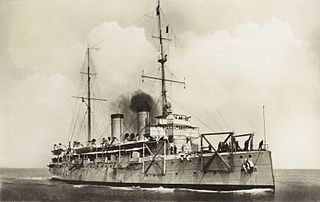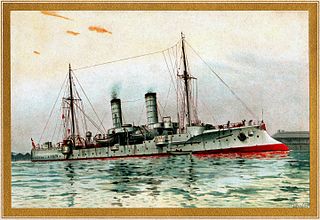Two cruisers of the German navy were named Niobe and built in 1898:
- SMS Niobe, in service 1900–1925
- German cruiser Niobe (Fijenoord, 1898), in service 1940–1944
Two cruisers of the German navy were named Niobe and built in 1898:
USS Topeka, named after the state capital Topeka, Kansas, may be any one of these United States Navy ships:
Six ships of the United States Navy have been named USS Cheyenne, in honor of the city of Cheyenne, Wyoming.
USS St. Louis may refer to:
Four vessels of the British Royal Navy have been named HMS Highflyer.

HNLMS Gelderland was a Holland-class cruiser of the Royal Netherlands Navy. During its career in the Dutch Navy it was most notable for being the ship Queen Wilhelmina sent to Portuguese East Africa to transport Paul Kruger to Europe during the Second Boer War. The ship was taken over by the Germans during World War II, rebuilt as an anti-aircraft cruiser and renamed Niobe. Commissioned into the German navy on 1 March 1944, she was sunk in Kotka harbour in Finland on 16 July 1944.

HMCS Rainbow was an Apollo-class protected cruiser built for Great Britain's Royal Navy as HMS Rainbow entering service in 1892. Rainbow saw time in Asian waters before being placed in reserve in 1909. In 1910 the cruiser was transferred to the Royal Canadian Navy for service on the west coast. At the outbreak of the First World War, Rainbow was the only major Commonwealth warship on the western coast of North America. Due to age, the cruiser was taken out of service in 1917 and sold for scrap in 1920 and broken up.
Niobe may refer to:
Several ships have borne the name Niobe, after the figure of Niobe in Greek mythology
Three German ships have been named SMS Hansa.

HMS Niobe was a ship of the Diadem class of protected cruisers in the Royal Navy. She served in the Boer War and was then given to Canada as the second ship of the newly created Naval Service of Canada as HMCS Niobe. The Naval Service of Canada became the Royal Canadian Navy in August 1911. The ship was nearly lost when she went aground off Cape Sable Island, Nova Scotia overnight 30–31 July 1911. Repairs were completed at the end of 1912 and the ship returned to service in late 1914. During the First World War, Niobe patrolled the approaches to the St. Lawrence River and then joined the Royal Navy's 4th Cruiser Squadron to patrol off New York City. The cruiser returned to Halifax, Nova Scotia on 17 July 1915 and never put to sea again. Niobe was paid off in September and served as a depot ship in Halifax. Damaged in the 1917 Halifax Explosion, she was sold for scrap and broken up in the 1920s.
SMS Cöln has been the name of two ships of the German Imperial Navy:
Fürst Bismarck may refer to:
Four ships of the Royal Navy have borne the name HMS Niobe, after the figure of Niobe in Greek mythology:

SMS Niobe was the second member of the ten-ship Gazelle class of light cruisers that were built for the German Kaiserliche Marine in the late 1890s and early 1900s. The Gazelle class was the culmination of earlier unprotected cruiser and aviso designs, combining the best aspects of both types in what became the progenitor of all future light cruisers of the Imperial fleet. Built to be able to serve with the main German fleet and as a colonial cruiser, she was armed with a battery of ten 10.5 cm (4.1 in) guns and a top speed of 21.5 knots. The ship had a long career, serving in all three German navies, along with the Yugoslav and Italian fleets over the span of more than forty years.

The Gazelle class was a group of ten light cruisers built for the Imperial German Navy at the turn of the 20th century. They were the first modern light cruiser design of the Imperial Navy, and set the basic pattern for all future light cruisers in Imperial service. The design of the Gazelle class attempted to merge the fleet scout with the colonial cruiser. They were armed with a main battery of ten 10.5 cm (4.1 in) guns and a pair of torpedo tubes, and were capable of a speed of 21.5 knots.
Châteaurenault has been the name of a number of ships of the French Navy, in honour of François Louis de Rousselet, Marquis de Châteaurenault:
Several naval ships were named Helgoland after the island of Heligoland or the Battle of Helgoland, an action during the Second Schleswig War.
USS Minneapolis-Saint Paul may refer to: